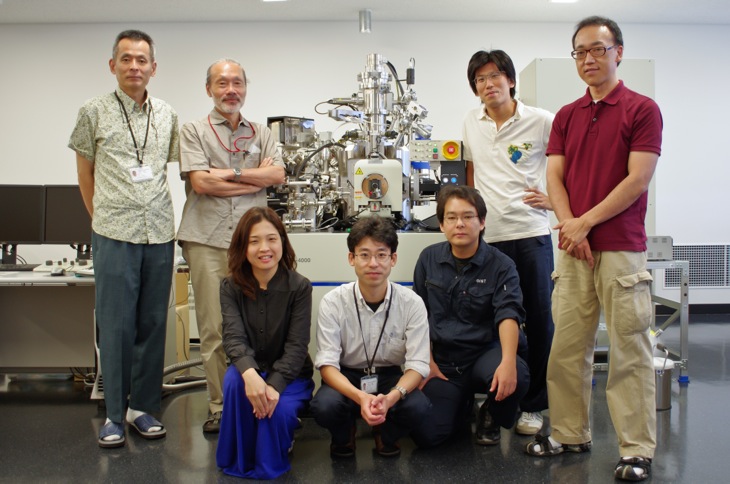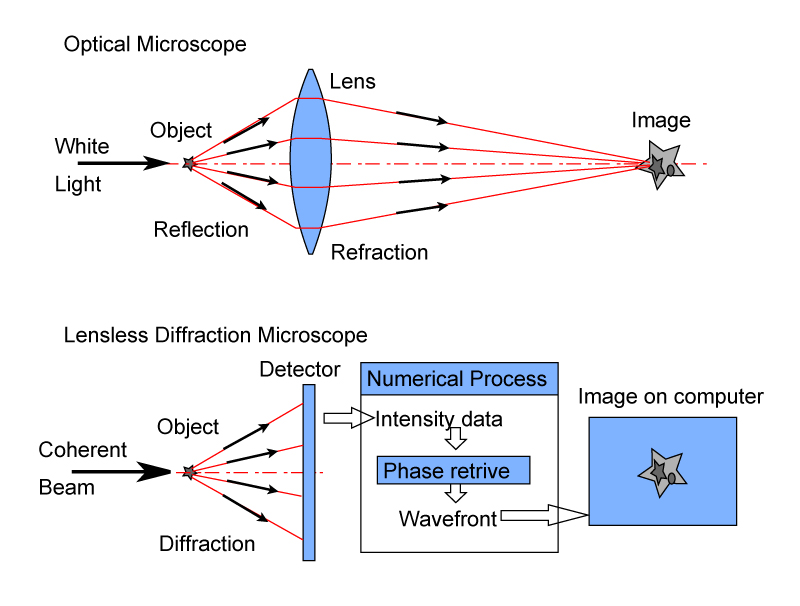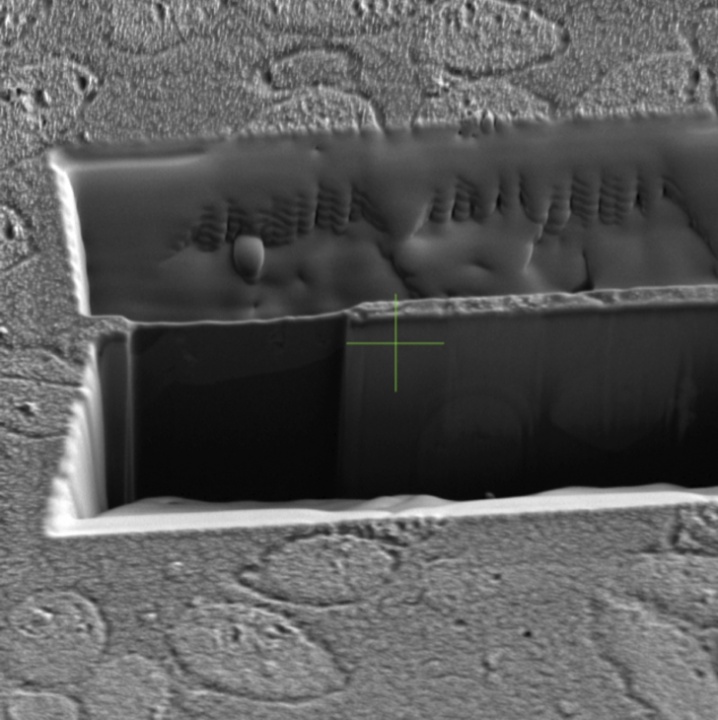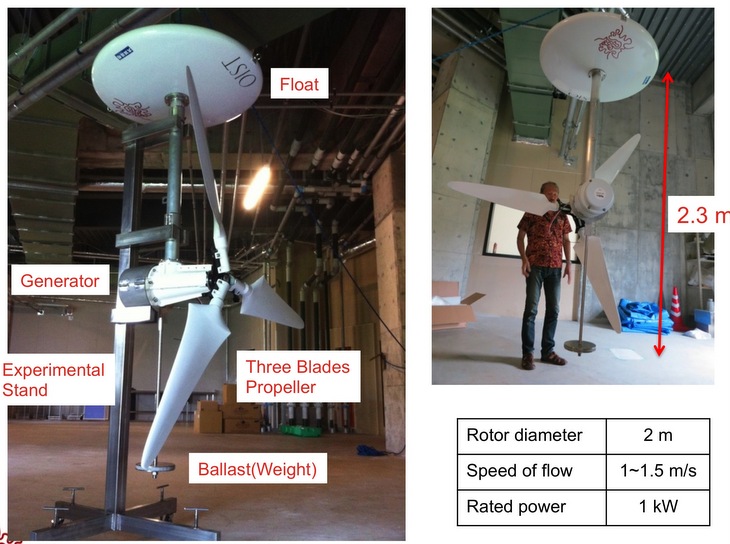FY2012 Annual Report
Quantum Wave Microscopy Unit
Professor Tsumoru Shintake

Abstract
1. R&D on diffraction electron microscope which uses the quantum wave interference associated with low energy electron as well as on the technique of electron holography. In the past this unit has developed a numerical technique for the holographic image reconstruction and phase retrieval scheme. In FY2012 the unit has developed diffraction electron microscope DMF4000 in collaboration with HITACHI High Tech Science. Simulation and design for an electron spectrometer have also been started.
2. Our ocean current turbine converts the kinetic energy of ocean current into electric power. So, we are going to moor the turbine in the ocean current from the seabed. The turbine drives an electric generator which are put in the nacelle. Therefore we need to cancel a reaction torque from the electric generator. In FY2011, we started conceptual design work to realize the torque cancellation. In FY2012, we developed the prototype machine and performed towing experiments.
1. Staff
- Dr. Katsutoshi Shirasawa, Researcher
- Dr. Hidehito Adaniya, Reseacher
- Dr. Ryo Yamashiro, Reseacher
- Dr. Teruhisa Hirai, Researcher
- Dr. Masao Yamashita, Researcher
- Ms. Reina Oshiro, Research Administrator
2. Collaborations
- Theme: Development of the ocean current turbine
- Type of collaboration: Joint research
- Researchers:
- Professor, Dr. Hidetsugu Iwashita, Hiroshima University
- Student, Kohei Tokunaga, Hiroshima University
3. Activities and Findings
3.1 Electron microscope group
Conceptual design of Diffraction electron microscope
In principle, by applying the method of iterative phase retrieval on coherent diffraction data, one can determine the phase of the diffraction beam, and reconstruct the real image of the sample object (Fig.1). This process works correctly if the object has a two dimensional structure. The phase of the diffraction beam from an object of three dimensional structure, however, cannot be determined uniquely. We have found that we may solve this problem by introducing holographic image reconstruction. To perform this experiment on biological sample, one may use an electron beam in low energy, below 1keV, to prevent the beam damage on the target sample. And the sample needs to be a thin enough to allow for the transmission of the diffracting electrons.

Figure 1: Concepts of normal optical microscope (single lens), and lensless diffraction microscope. We can totally eliminate the geometrical aberrations associated with magnetic lens, thus it will realize atomic resolution microscope.
Development of the electron diffraction microscope
The major progress in FY2012 was the development of electron diffraction microscope, DMF4000, which provides FIB-SEM operations (Focused Ion Beam – Scanning Electron Microscope). (Fig.2) DMF4000 has essential features to conduct electron diffraction experiment, such as FIB to fabricate a biological sample to a thin layer to allow for the transmission of electrons, and as SEM to create a low energy electron beam. With the FIB of DMF4000, we have developed a technique to slice out biological sample, such as yeast, to fabricate a layer of a few tens of nanometer thickness (Fig.3). The sample was first deposited with Pt, and then sliced out by Ga ion beam to a thin layer to diffract the incident electron beam.

Figure 2: Electron diffraction microscope DMF4000.

Figure 3: A layer of yeast sample facricated with the FIB of DMF4000.
3.2 Ocean Power Generaton Group
Development of the prototype machine
In order to confirm our attitude control system, we developed a prototype machine(Fig. 4). Our machine have a float at the top and a weight at the bottom. Thanks of the lift(buoyancy) and down(gravity) force, the nacelle body keeps the attitude stably by canceling the rotor torque. We used a turbine, electric genrator and nacelle of a commercial wind turbine, because we wanted to save time and focus to prove our attitude control method.

Figure 4: Photograph and main parameters of the prototype machine.
Towing experiment in the sea
The towing expriment was carried out in the sea (Fig. 5). A fishing boat towed our prototype machine to simulate the ocean current. We measured the output power of the electric generator. The obtained electric power was av. 300 W(peak 400 W) at 60 rpm blade rotation. The measured values are in good agreement with the values we expected. And , the prototype machine showed us the very stable attitude in the seawater.

Figure 5: Photograph of the first towing test in the sea.
Development of the turbine blade
Professor Iwashita's group (Hiroshima Univ.) and our unit developed a new tubine blade for the ocean current (Fig. 6). The blade was designed with Blade Element Momentum Method(BEM). The performance was measured by two kinds of experiments. First, we tested the new blade in the wind tunnel of the Hiroshima university. And then, we attached the blades to our prototype machine. As the second experiment, we performed towing measurement at the towing tank of Kyushu University. We successfuly obtained the power and thrust coefficients of the new blade. The results of the experiments gave good agreement with the designed values.
Figure 6: Photograph of the newly developed tubine. The diameter is 1.5 m. This turbine has been optimized for working in the water.
4. Publications
4.1 Journals
Nothing to report
4.2 Books and other one-time publications
Nothing to report
4.3 Oral and Poster Presentations
- Shintake,T., Future Perspective on X-ray Laser and Electron Microscopy based on High Performance Particle Beams, FEL 2012 NARA 34th International Free Electron Laser Conference, Nara, Japan, Aug 27, 2012
- Shintake,T., Technical Challenges of Atomic Microscopy in Bio-science, The 104th Congress of Japan Society of Medical Physics, Ibaraki, Japan, Sept 14, 2012
- Shintake,T., Principles and Technical Development of Quantum Interference Microscopy and Development of Ocean Current Power Generation System in OIST, School of Engineering, Kyushu University, Japan, Nov 21, 2012
- Shirasawa, K., Ohba, Y., Mitarai, S., Shintake, T., Prototype demonstration of the ocean current electric generator, Japan Wind Energy Symposium 2012, Tokyo, Japan, Nov 27-28, 2012
- Shintake, T., Understanding of radiation physics with Radiation2D software, The Japanese Beam Physics Club of Young Researchers 2012, Hiroshima, Japan, Dec 1, 2012
- Shirasawa, K., Development of an ocean current generator at OIST, RIAM Symposium
Ocean Renewable Energy Technologies, Fukuoka, Japan, Jan 25, 2013 - Shintake, T., SACLA X-ray FEL. How did we make it. What was right or wrong? PAL Laboratory, Phohang, Korea, Feb 1, 2013
- Shintake, T., Ocean Current Power Generation: The Future Starts in Okinawa, OIST Open Campus, Okinawa, Japan, Mar 3, 2013
5. Intellectual Property Rights and Other Specific Achievements
Nothing to report
6. Meetings and Events
6.1 Seminar
- Date: December 11, 2012
- Venue: OIST Campus Lab1
- Speaker: Dr. Keisaku Kimura (Professor Emirits, University of Hyogo)
- Title: Quality SuperLattice Made of Gold Nanoparticles: Preparation and Some Optical Properties
6.2 Seminar
- Date: November 14, 2012
- Venue: OIST Campus Lab1
- Speaker: Dr. Hirofumi Nema (Chuo University)
- Title: He(3) film on graphite in high magnetic fields
6.3 Seminar
- Date: October 23, 2012
- Venue: OIST Campus Lab1
- Speaker: Dr. Ryo Yamashiro (The University of Tokyo)
- Title: Developments of molecular state selectors and a coincidence velocity-map imaging spectrometer: Towards electornic stereodynamics in molecules
6.4 Seminar
- Date: August 6, 2012
- Venue: OIST Campus Lab1
- Speaker: Dr. Kanwarpal Singh (Institute national de la recherche scientifique (INRS))
- Title: Measurement of the pulsatile ocular dynamics of the fuman eye for glaucoma diagnosis
6.5 Seminar
- Date: July 26, 2012
- Venue: OIST Campus Lab1
- Speaker: Dr. Kiyoshi Ueda (Institute of Multidisciplinary Research for Advanced Materials Tohoku University)
- Title: FEL experimets of atoms and atomic clusters at FELs: EUV to X-rays
6.6 Seminar
- Date: June 12, 2012
- Venue: OIST Campus Lab1
- Speaker: Dr. Teruhisa Hirai (RIKEN SPring-8 Center)
- Title: Inamge Processing in Electron Crystallography
6.7 Seminar
- Date: June 5, 2012
- Venue: OIST Campus Lab1
- Speaker: Dr. Christoph Gerle (Kyoto University)
- Title: Understanding the mechanism of energy transduction by rotary ATPases through molecular electron microscopy



